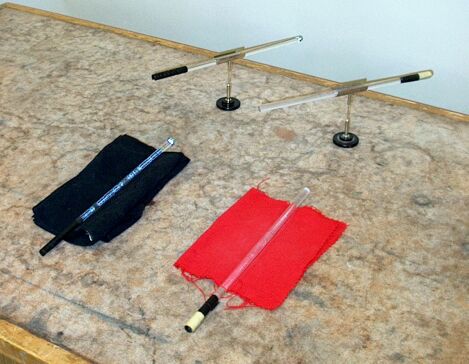
When you rub the plastic rod (polyethylene terephthalate, glycol modified, or PETG) with the wool cloth, the rod charges negative. When you rub the glass rod with the silk, the rod charges positive. If you place a charged rod on one of the swivel stands, and then bring another charged rod close to it, you can show electrostatic repulsion (similarly charged rods) or electrostatic attraction (oppositely charged rods).
This demonstration illustrates two things: triboelectricity and the electrostatic force. (The electrostatic force is sometimes called Coulomb force or Coulombic force, after Charles Augustin Coulomb. He was the first person to attempt to measure it directly, though other, indirect, measurements preceded his. The Coulomb, the unit of electrostatic charge, is named after him. See demonstration 56.24 -- Coulomb’s apparatus.) Since this demonstration does not allow for direct measurement of the electrostatic force between the two rods, it is merely qualitative in nature. The swinging around of the rods in their cradles, though, quite graphically shows the electrostatic repulsion or attraction between the different combinations of charged rods.
Triboelectricity, the transfer of charge between two objects by means of friction, depends on the varying affinities that different materials have for electrons. When you rub two materials together, the material that has the stronger affinity for electrons pulls them from the other material. (Merely touching the two materials together is sufficient to transfer at least some charge, but rubbing greatly improves the contact.) This leaves a net negative charge on the material that has gained electrons, and a net positive charge on the material that has lost electrons. One can rank materials in order of their tendency to pull electrons from other materials (or deposit them onto other materials), in a triboelectric series. For an article in which the authors construct several such series, see the following paper (from any UCSB-connected computer): A.F Diaz and R.M. Felix-Navarro, Journal of Electrostatics, 62(4) (2004) 277-290. The plastic rod in this demonstration is glycol-modified polyethylene terephthalate (PETG; polyethylene terephthalate would also work). Lucite (acrylic) rods are also available, but need a fur exciter to charge negative. When rubbed with wool, lucite charges positive.
We owe the designations of the sign of charge to Benjamin Franklin, who, when he performed experiments with glass and silk, and shellac and fur, named the charge deposited on the glass “positive,” and that deposited on the shellac “negative.”
Besides the attraction or repulsion of the charged rods towards each other, a good thing to show the class is the attraction between the rod and the cloth with which you have just rubbed it. Charging the plastic rod negative by rubbing it with the wool exciter leaves a net positive charge on the wool, so that if you place the rod on a swivel stand, you can then bring the wool exciter close to it and pull it around on the swivel stand. You can, of course, do the same thing with the glass rod and the silk.
References:
1) Halliday, David and Resnick, Robert. Physics, Part Two, Third Edition (New York: John Wiley and Sons, 1978), p. 566.